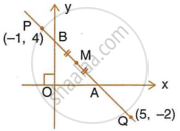Advertisements
Advertisements
Question
O(0, 0), A(3, 5) and B(−5, −3) are the vertices of triangle OAB. Find the equation of altitude of triangle OAB through vertex B.
Solution
The altitude through vertex B is perpendicular to OA.
Slope of OA = `(5 - 0)/( 3 - 0) = 5/3`
Slope of the required altitude = `(-1)/(5/3)= (-3)/5`
The equation of the required altitude through B is
y – y1 = m(x – x1)
`y + 3 = (-3)/5 (x + 5)`
5y + 15 = −3x − 15
3x + 5y + 30 = 0
APPEARS IN
RELATED QUESTIONS
Use graph paper for this question (Take 2 cm = 1 unit along both x and y-axis). ABCD is a quadrilateral whose vertices are A(2, 2), B(2, –2), C(0, –1) and D(0, 1).
1) Reflect quadrilateral ABCD on the y-axis and name it as A'B'CD
2) Write down the coordinates of A' and B'.
3) Name two points which are invariant under the above reflection
4) Name the polygon A'B'CD
Using a graph paper, plot the points A(6, 4) and B(0, 4).
- Reflect A and B in the origin to get the images A' and B'.
- Write the co-ordinates of A' and B'.
- State the geometrical name for the figure ABA'B'.
- Find its perimeter.
A straight line passes through the points P(–1, 4) and Q(5, –2). It intersects the co-ordinate axes at points A and B. M is the mid-point of the segment AB. Find:

- The equation of the line.
- The co-ordinates of A and B.
- The co-ordinates of M.
(1, 5) and (–3, –1) are the co-ordinates of vertices A and C respectively of rhombus ABCD. Find the equations of the diagonals AC and BD.
Show that A(3, 2), B(6, −2) and C(2, −5) can be the vertices of a square.
- Find the co-ordinates of its fourth vertex D, if ABCD is a square.
- Without using the co-ordinates of vertex D, find the equation of side AD of the square and also the equation of diagonal BD.
A line through origin meets the line x = 3y + 2 at right angles at point X. Find the co-ordinates of X.
O(0, 0), A(3, 5) and B(−5, −3) are the vertices of triangle OAB. Find the equation of median of triangle OAB through vertex O.
Point A and B have co-ordinates (7, −3) and (1, 9) respectively. Find:
- the slope of AB.
- the equation of perpendicular bisector of the line segment AB.
- the value of ‘p’ of (−2, p) lies on it.
Use a graph sheet for this question.
Take 1 cm = 1 unit along both x and y axis.
(i) Plot the following points:
A(0,5), B(3,0), C(1,0) and D(1,–5)
(ii) Reflect the points B, C and D on the y axis and name them as B',C'andD' respectively.
(iii) Write down the coordinates of B',C 'and D'
(iv) Join the point A, B, C, D, D ', C ', B', A in order and give a name to the closed figure ABCDD'C'B
Use a graph sheet for this question, take 2 cm = 1 unit along both x and y-axis:
- Plot the points A (3, 2) and B (5, 0). Reflect point A on the y-axis to A΄. Write co-ordinates of A΄.
- Reflect point B on the line AA΄ to B΄. Write the co-ordinates of B΄.
- Name the closed figure A’B’AB.
